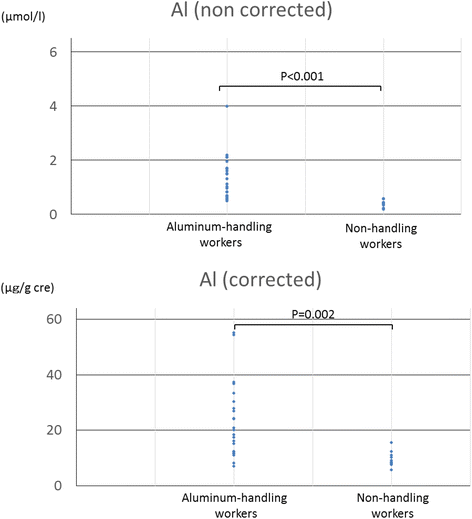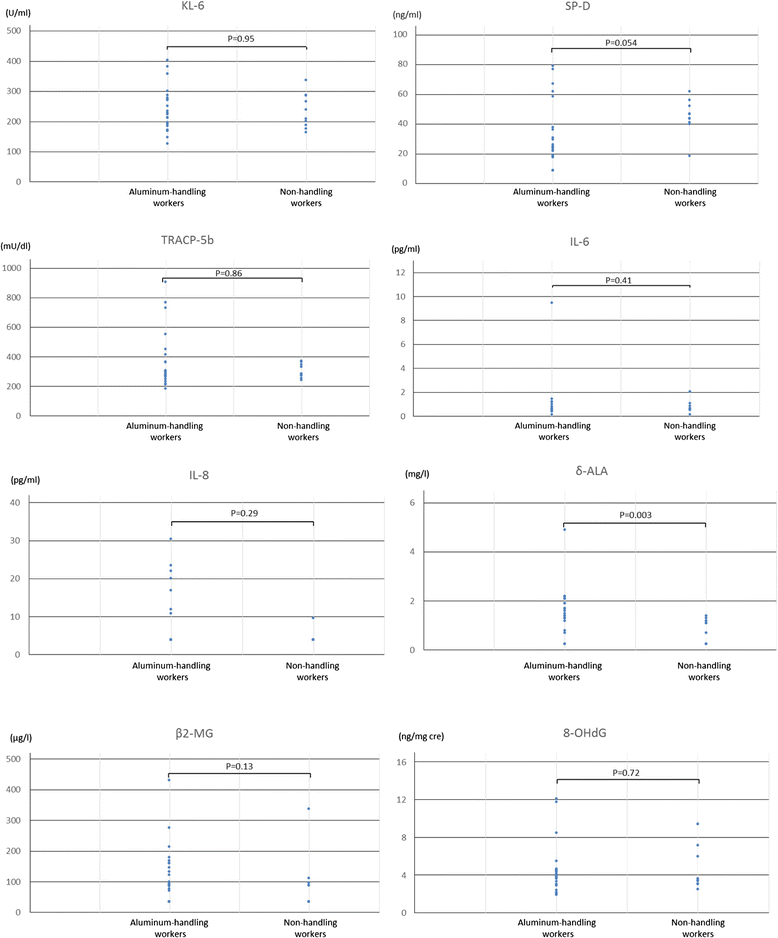A study of the association between urinary aluminum concentration and pre-clinical findings among aluminum-handling and non-handling workers
- PMID: 25866547
- PMCID: PMC4393619
- DOI: 10.1186/s12995-015-0055-8
A study of the association between urinary aluminum concentration and pre-clinical findings among aluminum-handling and non-handling workers
Abstract
Background: Aluminum is considered to be a relatively safe metal for humans. However, there are some reports that aluminum can be toxic to humans and animals. In order to estimate the toxicity of aluminum with respect to humans, we measured the aluminum concentration in urine of aluminum-handling and non-handling workers and investigated the relationships between their urinary aluminum concentrations and pre-clinical findings.
Methods: Twenty-three healthy aluminum-handling workers and 10 healthy non-aluminum-handling workers participated in this study. Their medical examinations, which were otherwise unremarkable, included the collection of urine and blood. Urinary aluminum levels were analyzed using ICP analysis. As pre-clinical tests, we measured KL-6, SP-D, TRCP-5b, IL-6, and IL-8 in blood and δ-ALA and β2-microglobulin in urine. These were considered to be lung, bone, kidney and inflammation markers. Moreover, we measured 8-OHdG in urine as an oxidative DNA damage marker.
Results: The aluminum concentration in urine ranged from 6.9 to 55.1 μg/g cre (median: 20.1 μg/g cre) in the aluminum-handling workers and from 5.6 to 15.6 μg/g cre (median: 8.8 μg/g cre) in the non-aluminum-handling workers, with a significant difference between them. In the pre-clinical findings, there were no significant differences between these two groups except in the case of δ-ALA. However, there were no significant relationships between aluminum concentration and the pre-clinical findings, work years, age or 8-OHdG in the aluminum-handling workers.
Conclusions: While the excretion of aluminum in urine was elevated in aluminum-handling workers, our findings suggest that low-dose aluminum is not directly harmful to humans, at least when workers' urinary aluminum concentration is below 55 μg/g cre.
Keywords: Aluminum; Biological monitoring; Pre-clinical marker.
Figures


Similar articles
-
Urinary 8-hydroxydeoxyguanosine as a biomarker of oxidative DNA damage in workers exposed to ethylbenzene.Ann Occup Hyg. 2011 Jun;55(5):519-25. doi: 10.1093/annhyg/mer010. Epub 2011 Mar 23. Ann Occup Hyg. 2011. PMID: 21430133
-
Total allowable concentrations of monomeric inorganic aluminum and hydrated aluminum silicates in drinking water.Crit Rev Toxicol. 2012 May;42(5):358-442. doi: 10.3109/10408444.2012.674101. Crit Rev Toxicol. 2012. PMID: 22512666 Review.
-
A 10-year Follow-up Cohort Study of the Health Effects in Toner-handling Workers.J UOEH. 2021;43(2):205-215. doi: 10.7888/juoeh.43.205. J UOEH. 2021. PMID: 34092765
-
Analysis of 8-hydroxydeoxyguanosine among workers exposed to diesel particulate exhaust: comparison with urinary metabolites and PAH air monitoring.Free Radic Res. 2005 Sep;39(9):963-72. doi: 10.1080/10715760500190115. Free Radic Res. 2005. PMID: 16087477
-
[Studies on the evaluation of exposure to industrial chemicals].Sangyo Eiseigaku Zasshi. 1996 May;38(3):119-37. Sangyo Eiseigaku Zasshi. 1996. PMID: 8689499 Review. Japanese.
Cited by
-
Increased Aluminum Content in Certain Brain Structures is Correlated with Higher Silicon Concentration in Alcoholic Use Disorder.Molecules. 2019 May 3;24(9):1721. doi: 10.3390/molecules24091721. Molecules. 2019. PMID: 31058813 Free PMC article.
-
Clinical Outcomes of the Deleterious Effects of Aluminum on Neuro-Cognition, Inflammation, and Health: A Review.Nutrients. 2023 May 8;15(9):2221. doi: 10.3390/nu15092221. Nutrients. 2023. PMID: 37432384 Free PMC article. Review.
-
Inerting Waste Al Alloy Dust with Natural High Polymers: Sustainability of Industrial Waste.Materials (Basel). 2022 Aug 12;15(16):5540. doi: 10.3390/ma15165540. Materials (Basel). 2022. PMID: 36013677 Free PMC article.
-
Local and Systemic Hypoxia as Inductors of Increased Aluminum and Iron Brain Accumulation Promoting the Onset of Alzheimer's Disease.Biol Trace Elem Res. 2023 Nov;201(11):5134-5142. doi: 10.1007/s12011-023-03599-y. Epub 2023 Feb 9. Biol Trace Elem Res. 2023. PMID: 36757557 Review.
-
Urinary aluminium and its association with autism spectrum disorder in urban preschool children in Malaysia.PeerJ. 2023 May 12;11:e15132. doi: 10.7717/peerj.15132. eCollection 2023. PeerJ. 2023. PMID: 37197586 Free PMC article.
References
-
- Food and Agriculture Organization of the United Nations: Summary report of the seventy-fourth meeting of JECFA [ftp://ftp.fao.org/ag/agn/jecfa/JECFA_74_Summary_Report_4July2011.pdf]
-
- Food and Agriculture Organization of the United Nations: Joint FAO/WHO food standards programme codex committee on contaminants in foods fifth session [ftp://ftp.fao.org/codex/meetings/CCCF/cccf5/cf05_INF.pdf]
-
- American Conference of Governmental Industrial Hygienists (ACGIH) Documentation of the TLVs and BEIs with other worldwide occupational exposure values [CD-ROM] Cincinnati: ACGIH; 2014. Aluminum metal and insoluble compounds.
-
- Al-Masalkhi A, Walton SP. Pulmonary fibrosis and occupational exposure to aluminum. J Ky Med Assoc. 1994;92:59–61. - PubMed
LinkOut - more resources
Full Text Sources
Other Literature Sources
Research Materials

